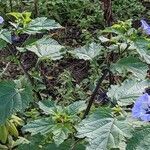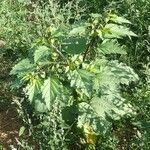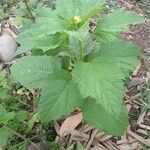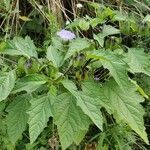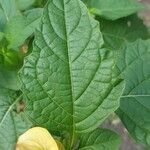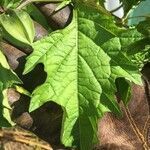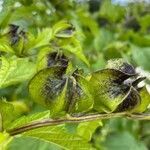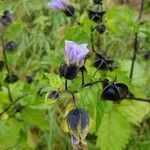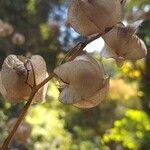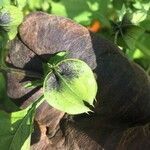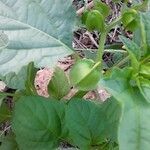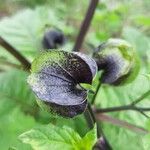Herb 15-60-(200) cm tall; stems usually green, sometimes purplish black on exposed side. Lvs with lamina partly decurrent or attenuate on petiole, 4-17 × 2-12 cm, ovate or triangular-ovate, often lobed (especially larger lower lvs) or sinuate-dentate, glabrous except sometimes for main veins beneath; apex obtuse to acute; upper lvs often sinuate and entire. Pedicels puberulent, usually green, sometimes purplish black. Calyx 1.5-2 cm long at anthesis, broad-ovate, deeply divided, usually green, sometimes purplish black, very strongly accrescent; apex cuspidate. Corolla 3-3.5 × 2.5-4.5 cm diam.; lower tube white, with 5 small or large purplish markings, the upper part blue; lobes blue, shallow and rounded. Filaments hairy, with base surrounded by tuft of long hairs. Fr. 1-2 cm diam. Seed 1.5-2 mm diam., subreniform or ± irregular, brown, with alveolate testa.
Erect, annual herb or shrub, up to 1.5 m high. Stems glabrous, angled and grooved, green or ± brown. Leaves ovate, up to 140 x 120 mm, margins irregularly dentate; petioles ± 40 mm long, ± pubescent. Flowers solitary, axillary; pedicels up to 30 mm long. Calyx up to 25 mm long, membranous, green, ± 5-winged. Corolla campanulate with lobes up to 40 mm in diam., blue or white. Flowering time mostly Nov.-May. Fruit globose berries, 10-15 mm in diam., ± yellow, glabrous, in enlarged, bladder-like calyces. Seeds many, ± lenticular, 1.5 mm in diam., glabrous, finely pitted, light brown.
Stems erect, angular, 40-150 cm tall, glabrescent or sparsely pubescent. Petiole 1.5-6 cm; leaf blade ovate or elliptic, 4-20 × 2-13 cm, papery, sparsely pubescent on both surfaces, base cuneate, margin lobed or coarsely sinuate-dentate, apex acute or short acuminate. Pedicel 1.5-4 cm. Calyx 0.8-3 cm, deeply parted; lobes broadly ovate, apex acute, 2.5-4 cm in diam. Corolla pale blue, blue-purple, or bluish with white center, 2.5-4 cm wide. Berry brown or yellow, 1-2 cm in diam. Seeds pale brown, 1-1.2 mm in diam. Fl. summer, fr. autumn.
Leaves alternate, membranaceous; petiole (0.5)1–7 cm long, ± winged, ± sheathing at the base; lamina (2)3–23.5(38) × (1)1.5–13.5(36) cm, ovate to lanceolate, sometimes triangular-or rhombic-ovate, ± oblong or elliptic, broadly cuneate to attenuate or occasionally truncate to subcordate, often oblique at the base, ± decurrent on the petiole, obtuse acute or acuminate at the apex, usually irregularly and coarsely toothed or lobed on the margins, glabrous or with a few small hairs mainly above, sometimes only on the nerves and the margins.
An annual herb. It branches freely. It is a large plant supported on stout stems. It can grow 50 cm to 4 m high. It is larger in warmer places. The stems are fluted or ribbed. They are pale green. They are hollow and become woody in older plants. The leaves are thin and flat. They are oval with wavy or toothed edges. The flowers are bell-shaped and lilac-blue. They are 2.5 cm across. These form papery pods. Inside there is a berry with seeds. The berry is 1-2 cm across. The seeds are 1-2 mm long.
Calyx green becoming brown and chartaceous, segments 5, 9–22 mm long, ovate,± strongly cordate-sagittate at the base and ± acuminate at the apex, concave, with adjacent margins doubled back (reduplicate) forming longitudinal wings, the margins fused for almost half their length, sparsely puberulous with small glandular hairs and scattered eglandular hairs; fruiting calyx brown and papery, accrescent, (1.8)2–3.5(4) × 1.6–3.7 cm, with segments strongly reduplicate and reticulately-veined.
Corolla pale pinkish violet or pale blue to purple on the limb and upper tube, usually whitish in lower part, (1.3)1.7–3 cm long, c. 27 mm in diameter, campanulate, with a mixture of very short glandular and eglandular hairs at least along the nerves, and also with numerous longer eglandular hairs inside the tube around the base of the filaments; tube often turning yellowish with age; limb (2)2.3–5(5.7) cm across, the lobes spreading.
Flowers erect at first then nodding, inserted beside the petiole-base and appearing axillary, or axillary in the upper leaves; pedicel (0.6)1.2–3(3.5) cm long, at least initially clothed with minute, 1–3-celled ± patent eglandular hairs, and also with a few many-celled glandular hairs; fruiting pedicel elongating to c. 4 cm.
Annual herb, up to 2 m high. Leaves ovate-oblong, sinuate-serrate, acuminate, up to 130 x 75 mm, petiolate. Flowers solitary. Calyx segments cordate, enlarging and completely enclosing berry. Flowers purple to mauve.
Fruit a dry berry, pale green to yellow or brown when ripe, erect, enclosed within the enlarged calyx, 12–18 mm in diameter, gynophore up to c. 2 mm long on the base of the calyx.
Stamen filaments 4–7 mm long, sometimes with long, eglandular hairs; anthers often greenish or bluish-margined, 2.5–3.5 mm long.
Annual herb, usually much-branched and often ± robust, (0.1)0.2–2.5(3) m high, sometimes purple tinged.
Branches glabrous or sparsely hairy at least around the nodes with a few simple, short hairs.
Ovary 2.5–4.5 × 2.4–5 mm; style 4–4.8 mm long, straight.
Seeds light to dark brown, 1.5–2 × 1.2–1.7 mm, sticky.
